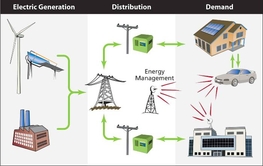Energy Positive buildings and electric cars: the new paradigm for energy savings ?
No-one can now be in doubt: in the construction industry the future belongs to Low Energy Buildings (LEB) and indeed Energy Positive Buildings (EPB). This is unavoidable if we are to cope with the reported scarcity of fossil fuels. But is it enough? Not necessarily! ”Designing dwellings or houses that save 80 kWh/m2 .y and living in, that’s fine says Daniel Quénard, a CSTB engineer. But the whole energy gain is wiped out if the occupants must travel about 20 km a day to go to work.” The logical consequence: In terms of energy efficiency, a global approach is required. This naturally leads to the development of sustainable communities, a concept in which buildings and transport form a unit.
Multipurpose cars
Parking lots, boxes, private garages: often nearby or even inside, the car is an integral part of buildings. This equipment of mobility much criticised but often essential remains unused most of the time. Is a new vision of the personal car possible?</o:p>
The car is the second highest household energy consumer after heating. “As of now the electricity produced by solar photovoltaic installations is generally fed back into the existing network, continues Daniel Quénard. The feed-in tariffs are very profitable, but will that continue? Could there not be a different energy management approach such as making the car a new equipment of EPB? Indeed, even if vehicles are symbols of freedom, they could also be used for energy storage through their batteries and as emergency system in case of power cut." We should add that production of electricity from nuclear or renewable energies to recharge batteries is the indispensable condition for a practically CO2 neutral vehicle. In addition, the impact of electrochemical batteries and production systems (PV, wind, solar concentration…) must not be ignored. Finally, the electric vehicles could become the essential link to public transportation … generally electric (train, tram).</o:p>
An "electrinet" to be fully developed
The 30 million private cars on French roads represent a significant energy potential, several times that of EDF. Many of them “sleep” in the vicinity of the 17 million private houses. Thus, as for information with Internet, a new idea is now gaining attention: To create an “electrinet”, a network of energy production sites and storage systems in which houses and cars would have an important part. Projects about this new paradigm are currently under development in the USA (NREL, Rocky Mountain Institute…) and among Japanese real estate developers. The objective: To develop a connection system between the electricity network and cars in buildings (both energy efficient and energy producers). The CSTB is not being left out, as it is taking active steps to carry out similar operations in the Rhône-Alpes region, in partnership with the CEA, INRETS and IFP.
“Building therapy”: building surfaces to increase well-being
Wall thickness and building height are essential characteristics of buildings, but in the current climate their surfaces represent underused “assets” for making the most of renewable energies and providing comfort for occupiers.
Air quality, lighting, heat, cold - all or nearly all depend on the surface available. There is general awareness of the use of roofs and façades to “collect resources”: air, water, light, energy …. In side too, the use of opaque and glazed walls is increasing as a matter of efficiency and comfort. Some examples?: Underfloor heating is already making it possible to move from hot spots (radiators) to a much more temperate surface which gives a far more comfortable ambience. The window, which lets daylight through, could be transformed in future into a diffuse light source during the night. Partition walls incorporating phase change materials (PCMs) will soon play an essential part in thermal comfort (surface temperature). Air treatment and its surface diffusion could also provide comfort and care. Enough to transform a building into a “well-being diffuser”! Then we’re on the way to “building therapy”?



